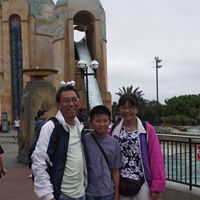Kam T Tam
age ~70
from La Jolla, CA
- Also known as:
-
- Kam To Tam
- Karen Tam
- Tam Kam
- Phone and address:
- 5444 Parkview Dr, La Jolla, CA 92037
Kam Tam Phones & Addresses
- 5444 Parkview Dr, La Jolla, CA 92037
- Seattle, WA
- San Diego, CA
- San Jose, CA
- San Francisco, CA
- Santa Clara, CA
- Brooklyn, NY
Work
-
Company:Qualcomm, inc.
-
Address:5775 Morehouse Dr, San Diego, CA 92121
-
Phones:(858)6515563
-
Position:Attorney
-
Industries:Legal Services
Education
-
School / High School:Syracuse University
Ranks
-
Licence:California - Active
-
Date:2000
Us Patents
-
Episcopic Projector
view source -
US Patent:50338420, Jul 23, 1991
-
Filed:Feb 13, 1990
-
Appl. No.:7/479377
-
Inventors:Kam T. Tam - San Jose CA
-
International Classification:G03B 2108
G03B 2130 -
US Classification:353 66
-
Abstract:An apparatus and method for projecting optical images from opaque or transparent objects onto a remote viewing screen includes a plane mirror combination and a reflective projection means. The plane mirror combination comprises an image inverting plane mirror and an image reversing plane mirror. The image inverting plane mirror is positioned angularly over the illuminated object and converts the upright and nonreversed object image into an inverted and reversed image. Disposed close by the image inverting plane mirror is the reflective projection means which comprises a parabolic concave mirror the parabolic concave mirror captures the inverted and reversed image and projects it onto the image reversing plane mirror near by as an enlarged, upright and reversed image. In return, the image reversing plane mirror reflects the enlarged, upright and reversed image onto the remote viewing screen as an enlarged, upright and nonreversed real image. The apparatus and method is convenient to operate and with the objects to be projected accessible to the operator but without the irritation of stray light glares affecting the operator's eyesight.
-
Power-On-Concurrent Maintenance
view source -
US Patent:50776754, Dec 31, 1991
-
Filed:Oct 4, 1989
-
Appl. No.:7/416866
-
Inventors:Kam T. Tam - San Jose CA
-
Assignee:Amdahl Corporation - Sunnyvale CA
-
International Classification:H02H 720
-
US Classification:364480
-
Abstract:A power sequencer for connecting a system to an electrical power supply without powering down the system and without damage to the system or the power supply. A plurality of sequentially engageable contacts are coupled to the power supply for receiving power signals. The contacts are spatially positioned to toggle in a predetermined sequence during engagement. A controller is coupled to the contacts, for supplying a terminal signal to the load in response to the predetermined sequence of toggling of the contacts and in response to the power signals. The controller has a control circuit for generating a control signal which varies in response to the sequence, and a regulator, coupled to the control circuit, for regulating the terminal signal in response to the control signal.
-
Luminous Screen Projector
view source -
US Patent:49782177, Dec 18, 1990
-
Filed:Feb 20, 1990
-
Appl. No.:7/482225
-
Inventors:Kam T. Tam - Santa Clara CA
-
International Classification:G01B 2128
-
US Classification:353119
-
Abstract:An apparatus and method for projecting optical images from electronic devices with luminous screens such as television receivers or computer terminal displays includes an image inversion means and a reflective projection means. The image inversion means comprises an assembly of two normally intersecting plane mirrors disposed close by the luminous screen. Object images from the luminous screen enter into one of the mirrors of the image inversion means as an upright and nonreversed image and are reflected by the other plane mirror out of the image inversion means as an inverted and nonreversed image. The reflective projection means comprises a parabolic concave mirror, positioned close by the image inversion means, and which captures the inverted and nonreversed image and projects it into a remote viewing screen as an enlarged, upright and nonreversed real image. The apparatus and method is designed to be adaptable to luminous screens of various sizes and capable of projecting high quality images without resorting to any alterations of electronics or complicated optics.
Resumes

Kam Tam
view source
Kam Tam
view source
Kam Leng Tam
view source
Kam Tam
view sourceLawyers & Attorneys

Kam T Tam, San Diego CA - Lawyer
view sourceAddress:
5775 Morehouse Dr, San Diego, CA 92121
(858)6515563 (Office)
(858)6515563 (Office)
Licenses:
California - Active 2000
Education:
Syracuse University
Santa Clara University School of Law
Santa Clara University School of Law
Name / Title
Company / Classification
Phones & Addresses
Attorney
Qualcomm, Inc.
Legal Services
Legal Services
5775 Morehouse Dr, San Diego, CA 92121
Owner
Pharmacy Store
Ret Drugs/Sundries
Ret Drugs/Sundries
333 9 St, Oakland, CA 94607
President
E & T CONSTRUCTION, INC
Single-Family House Construction
Single-Family House Construction
1452 Clb Vw Dr, El Cerrito, CA 94530
708 40 St, Richmond, CA 94805
1452 Clb Vw Ct, Richmond, CA 94530
708 40 St, Richmond, CA 94805
1452 Clb Vw Ct, Richmond, CA 94530
Vice-President
New Oakland Pharmacy Summit
Ret Drugs/Sundries
Ret Drugs/Sundries
401 29 St, Oakland, CA 94609
250 E 18 St, Oakland, CA 94606
(510)8390128
250 E 18 St, Oakland, CA 94606
(510)8390128
Vice-President
New Tiburcio Vasquez Health Mart Pharmacy
Ret Drugs/Sundries
Ret Drugs/Sundries
33225 9 St, Union City, CA 94587
Principal
Clinics
Medical Doctor's Office
Medical Doctor's Office
747 52 St, Oakland, CA 94609
Principal, Vice-President, President
New Oakland Pharmacy
Pharmaceuticals · Ret Drugs/Sundries · Ret Drug Store
Pharmaceuticals · Ret Drugs/Sundries · Ret Drug Store
333 9 St, Oakland, CA 94607
388 9 St #108, Oakland, CA 94607
822 Webster St, Oakland, CA 94607
(510)7633282, (510)8138687, (510)6280368, (510)6280323
388 9 St #108, Oakland, CA 94607
822 Webster St, Oakland, CA 94607
(510)7633282, (510)8138687, (510)6280368, (510)6280323
Owner, Principal, Pharmacist, Vice-President
Oakland Pharmacy Inc
Ret Drugs/Sundries
Ret Drugs/Sundries
5220 Claremont Ave, Oakland, CA 94618
(510)4284088
(510)4284088
Myspace
Flickr

Kam Tam
view source
Man Kam Tam
view source
Kam Tam
view source
Cindy Mee Kam Tam
view source
Kam Hong Tam
view source
Tam Kam
view source
Kam Tam
view source
Kam Tong Tam
view sourceClassmates

Kam Tam
view sourceSchools:
Duanesburg Central High School Delanson NY 1991-1995
Community:
Kitty Allen, Debbie Neadle, Kenneth Manley, Ella Bufford
Googleplus

Kam Tam

Kam Tam

Kam Tam

Kam Tam
Youtube
Get Report for Kam T Tam from La Jolla, CA, age ~70














